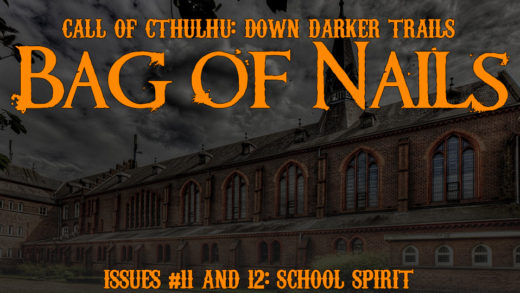Gamers will find a way. Even before personal computers existed, much less talk to each other, there were methods to enjoy tabletop RPG games without the tabletop. Thanks to advances in technology, there are more choices than ever for people to find the best group that suits them and the games they want to play, no matter how remote they may be. In this post I list out the methods of online tabletop that I’ve tried and how they worked (or didn’t work) for me.
Play By Post/Email
Play by post is one of the oldest forms of long-distance RP, pre-dating the ubiquity of home computers. Players would send mail to a GM, who would then correspond back to the players. Games could (and often did) take months or years. Thankfully, even with dial-up modems, the pace of the game could break dependence on hand-delivery, and gaming via email or on forums/post-based chat boards rose up alongside their “parent.”
The play by post style of gaming requires patience and planning. Because of the pacing, this style of gaming requires a very adaptable plot and is rarely well-suited for tight storylines. I’ve tried my hand at both running and playing in play by post games, but they’ve often fallen apart within the first few months. While some players were able to post multiple times a day, other players could take days to a week to perform an action or respond. This unevenness of interaction caused the games I was in to crumble, as the more prolific players would get bored waiting for the rest of the group. So, I’ve never had much luck with this style of gaming. If one is patient and persistent and finds a group with a similar pace of response, it can work, though. I know of others who spend 30 minutes to an hour a day posting in a campaign that’s lasted years.
Chat Room & IRC
Chat room systems break the barriers of waiting for the next post and has allowed for long-distance play as early as pre-Internet, dial-up BBS (Bulletin Board System) days. Players log in at an established time and a text-based game is run in real-time. As chat room systems evolved, more features were added. Players would be able to send hidden messages to the GM or other players, dice rolls could be electronic and visible (to reduce cheating), and stats and hit-points could be tracked digitally. Arguably, the most popular current form of chat room play exists through Internet Relay Chat, or IRC. Specific server and channel (or group) information is shared with players and they connect using IRC software (or a web interface) and actions and responses occur as quickly as people can type.
I’ve played in a number of successful live chat room RPG campaigns; on BBSes, AOL Chat, and IRC. Each session featured a specific adventure that was completed by the designated “end time.” Because travel was not required (and possibly because I was younger and had more free time), sessions would typically last 6 or more hours. This style of online play did require users who could not only read and type quickly, but also express their thoughts succinctly in text. Those who could not would often be left behind or trapped in what’s known as “scroll hell,” reading posts from minutes before while the wall of text responses kept growing. However, for those that can keep up and who do communicate better in writing than speech, it can be a rewarding style of gaming.
MU*
The MUD, or Multi-User Dungeon, and its child variants like the MUSH (Multi-User Shared Hallucination) were the pre-cursors to the MMORPGs like Ultima Online and EverQuest. Because of the diversity in style and programing languages, the MU part of the prefix has numerous suffixes. The MU* format of play is live chat based, like chat rooms, but in a MUD the GM is also a programmer, who has scripted specific rooms and challenges beforehand. In some instances, additional graphics like maps or characters may be presented. In other instances, users may have the ability to add additional rooms or areas to the environment–provided they have the knowledge and skills to do so. While it’s generally preferred for players to play at the same, scheduled time there is nothing to prevent users from wandering the environment on their own. Arbitration of rules is typically decided by the scripted code or by agreement of the players present and a live GM is not required for this sort of play.
Like the MMOs that came after them, there’s rarely a clear cohesive direction for a group to follow unless the game is more combat-oriented. This is due, in part, to the lack of a live GM guiding events. As such, I’ve not had much luck role-playing in the MU* environment. I’ve rarely been able to “get in character” while playing or have found myself wandering in empty areas unable to find other players. There are still new and active MU*s out there, so others are likely having better luck than I am.
Video Conferencing
Thanks to Internet connection speeds increasing for the general populace, gaming face-to-face, albeit in separate locations, is possible. With that, a whole range of options for video conferencing RP is possible. Skype, GoToMeeting, WebEx, et al allow users to type, share and display files, as well as see the faces of their fellow players and hear their voices. This allows for the closest experience to tabletop gaming. The use of technology also provides more discreet methods for passing notes. However, generic video chatting often means dice rolls can often be faked, requiring a certain amount of trust amongst players.
I’ve used both Skype and GoToMeeting for standard video conference online tabletop play. Video conferencing is my most preferred method of online tabletop play, as I am a player who tends to use different voices and phrases of speech for my characters that can be harder for me to type than to simply say. However, video conferencing does have its pitfalls. While some players can become distracted by out-of-game factors in any gaming interface (including actual tabletop), it seems more prevalent in video conferencing gaming. Technical issues and cut-offs are also more likely due to the amount of information that’s being transferred. Background noises of another player’s household can also distract the group. Also, with the more generic, non-RPG, video chatting options, GMs and players often have to pass “control” of the game to another in order to share any files so technology coordination is required from all players for the best experience.
The interfaces below are RPG-specific instances of video conferencing. As such, they share some of the inherent difficulties of any video chatting software, which I mentioned, but do provide game-specific tools standard video conferencing often does not, like dice rolls or character sheet integration.
Infrno
Infrno is a web-based video conferencing interface that allows users to create or find a scheduled game in a variety of systems. Once created, approved (typically immediately via the system), and scheduled players can transfer or write up their characters (the interface for characters is game generic) and launch what Infrno refers to as the “game table.” The table provides views to character sheets, picture sharing, dice rolling, and some various drawing/pointing functions. Infrno can be used for free, but includes advertisement, a limited amount of games and characters. Higher subscription models of ($4.99 or $14.99 USD a month) hide advertisements and allow for unlimited games and characters. The higher subscription also allows users to flag games or characters as private, viewable only by invited users. While cutting edge for its time, the interface still requires Flash (a barrier for the more security-minded users) and has not been updated for some time.
Roll20
Roll20 is also a web-based video conferencing interface. For subscribers, it also has optimized tablet support. Roll20 offers many of the features Infrno does but is written in HTML5, wiping away the potential Flash barrier. The software allows GMs to place a grid map on a shared screen and for users to have character tokens, the map can share distance data, so the group is able to determine the feasibility of move actions. Character sheets are game-specific and can be shared or private based on GM discretion. While free (with advertisements), I’d advise GMs at least subscribe to the “Plus” ($4.99 a month) account to allow for custom game backgrounds and unlimited game listings. I highly recommend the “Pro” ($9.99 a month) account so that players can be supplied with tokens that come “free” in the pro library. Other character tokens can also be purchased separately in various packs. Roll20 is the software I use when I can’t game with a group on physical tabletop.
Fantasy Grounds
Fantasy Grounds uses installed software, rather than being web-based. It’s available for direct download from the site or can be purchased from Steam. Fantasy Grounds offers both a subscription model as well as a one time purchase license. In order for groups to use more than the base, limited, demo, the GM must either have the “Ultimate” license ($9.99 a month or $149 one time) or all players must have the “Standard” license ($3.99 a month or $39 one time). Unlike Infrno and Roll20, Fantasy Grounds offers direct support of multiple systems and supplements, offering not just character sheets but specific rule sets, options, and published adventures. Supplements and adventures, however, come at additional costs and often equal the price of the physical book. This can make using Fantasy Grounds cost-prohibitive for many GMs or groups. The interface also has a learning curve and I found it less than intuitive than other programs. For those willing to put the time in to understand the software and pay the costs, Fantasy Grounds can replace the physical tabletop experience for online one and that seems to be their aim. It is not recommended for players that may only need occasional online tabletop play.


Recent Comments